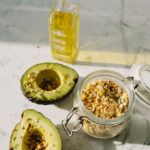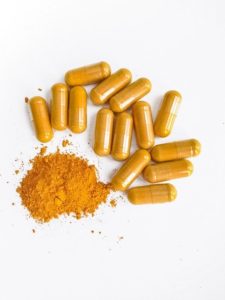 Turmeric…
Turmeric…
the real deal or just a bunch of hype?
Is it really as beneficial as some people claim? We have several family members and friends who have dealt with arthritis and cancer who have asked, “what is the deal with turmeric?”
We are here to tell you why you should get to know this powerful mellow yellow spice!
First, how do you say it?
It is pronounced TER-muh-rihk (although you are likely to hear many different pronunciations).
What is it?
 Turmeric was first cultivated in India (it is known as the “golden spice of India” or “Indian saffron”) and Southeast Asia — it has been harvested for more than 5,000 years! The golden root of the turmeric herb is part of the same family as ginger. It even looks like ginger, but it turns things a vibrant orange-yellow color – so beware, it can easily stain!
Turmeric was first cultivated in India (it is known as the “golden spice of India” or “Indian saffron”) and Southeast Asia — it has been harvested for more than 5,000 years! The golden root of the turmeric herb is part of the same family as ginger. It even looks like ginger, but it turns things a vibrant orange-yellow color – so beware, it can easily stain!
Some describe the taste as slightly bitter or pungent. Others say it is a little spicy. Turmeric is the main ingredient in curry dishes and is commonly used as food coloring in dairy products, baked goods, ice cream, beverages, cereals and more. If you see banana or lemon-flavored foods, chances are that turmeric helps provide the color. The reformulated cheese packet in Kraft mac & cheese uses turmeric for its distinctive color. It is also the reason ballpark mustard is yellow!
Why should we include it in our routine?
 One of the most potent and well-studied components of turmeric is curcumin. There is a large universe of scientific studies on curcumin and its anti-inflammatory effects. Reducing inflammation is one of the best ways to reduce the likelihood of the chronic diseases that have become so prevalent in our society. There is a long list of health benefits associated with turmeric…here are a few:
One of the most potent and well-studied components of turmeric is curcumin. There is a large universe of scientific studies on curcumin and its anti-inflammatory effects. Reducing inflammation is one of the best ways to reduce the likelihood of the chronic diseases that have become so prevalent in our society. There is a long list of health benefits associated with turmeric…here are a few:
- Includes beneficial nutrients such as vitamins B6 and C, fiber, magnesium, iron and potassium.
- Relieves arthritis and joint pain.
- Powerful cancer fighter. It does this in a variety of ways, including activating an anti-cancer enzyme in the liver, which inhibits the growth of cancer cells. It has also been shown to prevent cancer cells from forming in the first place.
- Helps prevent heart disease by lowering LDL (bad cholesterol) and preventing the oxidation of cholesterol in our bodies.
- Evidence exists that it helps reduce the risk of Alzheimer’s and other neurological diseases.
- It is even used in the cosmetic industry to help remedy skin conditions such as acne.
Now that is one powerful spice!
And that’s not all!
 It has also been shown to be as effective as some medications in treating depression!
It has also been shown to be as effective as some medications in treating depression!
Zonya hosted a discussion last week on the Top Foods that Fight Depression and we discussed this in our Good Food = Good Mood coaching tip last week. And, if you are interested, Zonya is kicking off a four-week livestream series called How Greens Fight the Blues, which will include even more information on how anti-inflammatory spices like turmeric can enhance your emotional well-being.
How can you include it in your routine?
 On its own, turmeric has a pungent flavor. However, it is easily incorporated into your meals in a way that that isn’t overpowering. Many recommend a daily dose is 1/4 to 1/2 tsp of turmeric in powder or dried form.
On its own, turmeric has a pungent flavor. However, it is easily incorporated into your meals in a way that that isn’t overpowering. Many recommend a daily dose is 1/4 to 1/2 tsp of turmeric in powder or dried form.
Of course, you can enjoy a cancer-fighting, brain-boosting serving of turmeric in the delicious Turmeric Latte.
Plus, you can easily add it to roasted or sautéed vegetables or add it to your favorite soup, veggie dip, rice, eggs, lentils, smoothies, or mix it into your salad dressing! It also pairs especially well with fish, chicken, chili, and of course, most Thai or curry dishes. For a higher curcumin content, you can use turmeric instead of, or in addition to, curry powder in your recipes. Here are even more great meal ideas for inspiration!
- Slow Cooker Asian Chicken Over Cauliflower Rice
- Spiced Middle Eastern Butternut Squash
- Turmeric Pork and Cabbage Skillet
 White Castle Inspired Burgers
White Castle Inspired Burgers- Slow Cooker Brazilian Style Chicken
- One Pot Moroccan Vegetable Curry
- Curry Spiced Kale Chips
- Indian Inspired Chicken Kabobs
- One-Pot Chicken and Rice
- Cauliflower Stir-Fry
- Apple Carrot and Pecan Curry Slaw
- Tuna Lettuce Wraps with Mango and Jalapeño
- One-Pot Chicken and Sausage Paella
- Indian Spice Burger with Mango Salsa
- Baked Tuna Noodle Skillet
- …and even more here!
Turmeric on its own isn’t enough!
TURMERIC + FAT + BLACK PEPPER = HUGE HEALTH BENEFITS!

 The curcumin found in turmeric actually has low levels of what is called “bioavailability,” which is an indicator of how easily your body absorbs the nutrients.
The curcumin found in turmeric actually has low levels of what is called “bioavailability,” which is an indicator of how easily your body absorbs the nutrients.
Studies have shown that adding black pepper with turmeric DRAMATICALLY increase its bioavailability by as much as 1,000x!
Turmeric is also fat-soluble, so in order to get the benefits of this super spice, you need to consume it with some fat. This can be a healthy oil (such as olive oil with sautéed or roasted veggies), or with an egg, avocado or a little milk. Remember to sprinkle black pepper on those eggs too!
Is it best to get turmeric from food or supplements?
 Different people will provide different answers to this question. Based on everything we have read and people we have talked to, our view is it is best to get the benefits from your food. This allows you to enjoy the flavor and prepare it in a way where it is absorbed by your body (including a little fat and black pepper).
Different people will provide different answers to this question. Based on everything we have read and people we have talked to, our view is it is best to get the benefits from your food. This allows you to enjoy the flavor and prepare it in a way where it is absorbed by your body (including a little fat and black pepper).
If you don’t like the taste or cannot get enough of it in your diet, then you can consider taking turmeric in supplement form. To get the benefit from a supplement, it should contain at least 95% standardized curcumin, with no preservatives or artificial colors. Ideally, it should contain black pepper extract or piperine to help with absorption (or just down a few shakes of black pepper seeds with your supplement!). As with any supplements, it is possible to get too much of a good thing, so make sure to get good guidance on the appropriate dose.
Make sure you are getting all the benefits turmeric has to offer!
We would love to hear your favorite ways to incorporate turmeric into your routine!
Thank you to Kratom IQ for the Turmeric supplement photo.
 LEARN MORE ABOUT THE NAPKIN!
LEARN MORE ABOUT THE NAPKIN!

I have soup most days (for breakfast!), typically some variation of bean & veggie. I add 1/4 teaspoon of turmeric, as well as 1/4 tsp garlic powder, several grinds of black pepper, and 1/2 tbsp of ground flax.